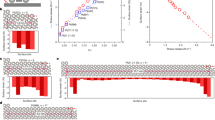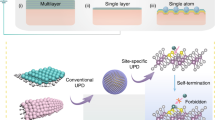Abstract
The reactivity of catalytic surfaces is often dominated by very reactive low-coordinated atoms such as step-edge sites1,2,3,4,5,6,7,8,9,10,11. However, very little knowledge exists concerning the influence of step edges on the selectivity in reactions involving multiple reaction pathways. Such detailed information could be very valuable in rational design of new catalysts with improved selectivity. Here we show, from an interplay between scanning tunnelling microscopy experiments and density functional theory calculations, that the activation of ethylene on Ni(111) follows the trend of higher reactivity for decomposition at step edges as compared with the higher-coordinated terrace sites. The step-edge effect is considerably more pronounced for the C–C bond breaking than for the C–H bond breaking, and thus steps play an important role in the bond-breaking selectivity. Furthermore, we demonstrate how the number of reactive step sites can be controlled by blocking the steps with Ag. This approach to nanoscale design of catalysts is exploited in the synthesis of a new high-surface-area AgNi alloy catalyst, which is tested in hydrogenolysis experiments.
This is a preview of subscription content, access via your institution
Access options
Subscribe to this journal
Receive 12 print issues and online access
$259.00 per year
only $21.58 per issue
Buy this article
- Purchase on Springer Link
- Instant access to full article PDF
Prices may be subject to local taxes which are calculated during checkout



Similar content being viewed by others
References
Taylor, H. S. A theory of the catalytic surface. Proc. R. Soc. London Ser. A 108, 105–111 (1925).
Gwathmey, A. T, Cunningham, R. E The influence of crystal face in catalysis. Adv. Catal. 10, 57–95 (1958).
Somorjai, G. A. Surface Chemistry and Catalysis (Wiley, New York, 1994).
Yates, J. T. Jr, Surface chemistry at metallic step defect sites. J. Vac. Sci. Technol. A 13, 1359–1367 (1995).
Zambelli, T., Wintterlinn, J., Trost, J. & Ertl, G. Identification of the “active sites” of a surface-catalyzed reaction. Science 273, 1688–1690 (1996).
Dahl, S. et al. Role of steps in N2 activation on Ru(0001). Phys. Rev. Lett. 83, 1814–1817 (1999).
Nørskov, J. K. et al. Universality in heterogeneous catalysis. J. Catal. 209, 275–278 (2002).
Liu, Z. P. & Hu. P. General rules for predicting where a catalytic reaction should occur on metal surfaces: A density functional theory study of C–H and C–O bond breaking/making on flat, stepped, and kinked metal surfaces. J. Am. Chem. Soc. 125, 1958–1967 (2003).
Zubkov, T. et al. The effect of atomic steps on adsorption and desorption of CO on Ru(109). Surf. Sci. 526, 57–71 (2003).
Gambardella, P. et al. Oxygen dissociation at Pt steps. Phys. Rev. Lett. 87, 056103 (2001).
Ciobîcã, I. M. & van Santen, R. A. Carbon monoxide dissociation on planar and stepped Ru(0001) surfaces. J. Phys. Chem. B 107, 3808–3812 (2003).
Lehwald, S. & Ibach, H. Decomposition of hydrocarbons on flat and stepped Ni(111) surfaces. Surf. Sci. 89, 425–445 (1979).
Besenbacher, F., Nielsen, L. P. & Sprunger, P. T. in The Chemical Physics of Solid Surfaces and Heterogeneous Catalysis Vol. 8 (eds King, D. A. & Woodruff, D. P.) Ch. 10 (Elsevier, Amsterdam, 1997).
Sinfelt, J. H. Bimetallic Catalysts, Discoveries, Concepts, and Applications (Wiley, New York, 1983).
Lægsgaard, E., Besenbacher, F., Mortensen, K. & Stensgaard, I. A fully automated, “thimble-size” scanning tunnelling microscope. J. Microsc. 152, 663–669 (1988).
Besenbacher, F. Scanning tunnelling microscopy studies of metal surfaces. Rep. Prog. Phys. 59, 1737–1802 (1996).
Hammer, B, Hansen, L. B. & Nørskov, J. K. Improved adsorption energetics within density-functional theory using revised Perdew-Burke-Ernzerhof functionals. Phys. Rev. B 59, 7413–7421 (1999).
Vanderbilt D. Soft self-consistent pseudopotentials in a generalized eigenvalue formalism. Phys. Rev. B 41, 7892–7895 (1990).
J´onsson, H, Mills, G. & Jacobsen, K. W. in Classical and Quantum dynamics in Condensed Phase Simulations (eds Berne, B. J., Ciccotti, G. & Coker, D. F.) Ch. 16 (World Scientific, Singapore, 1998).
Acknowledgements
We acknowledge the financial support from the European Union through the contract HPRN-CT-2002-00170.
Author information
Authors and Affiliations
Corresponding author
Ethics declarations
Competing interests
The authors declare no competing financial interests.
Rights and permissions
About this article
Cite this article
Vang, R., Honkala, K., Dahl, S. et al. Controlling the catalytic bond-breaking selectivity of Ni surfaces by step blocking. Nature Mater 4, 160–162 (2005). https://doi.org/10.1038/nmat1311
Received:
Accepted:
Published:
Issue Date:
DOI: https://doi.org/10.1038/nmat1311
This article is cited by
-
Bimetallic Ni–Zn/TiO2 catalysts for selective hydrogenation of alkyne and alkadiene impurities from alkenes stream
Research on Chemical Intermediates (2021)
-
Mechanistic insight into carbon-carbon bond formation on cobalt under simulated Fischer-Tropsch synthesis conditions
Nature Communications (2020)
-
Step-confined thin film growth via near-surface atom migration
Nano Research (2020)
-
Active catalyst construction for CO2 recycling via catalytic synthesis of N-doped carbon on supported Cu
Nature Communications (2019)
-
Carboxylic acid-modified metal oxide catalyst for selectivity-tunable aerobic ammoxidation
Nature Communications (2018)



